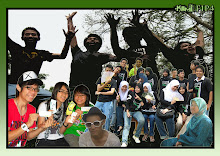 |
| ~Sumber Inspirasi Seorang Bakal Guru~ |
Seorang bakal guru ini memulakan pengajian di peringkat sekolah rendah selama enam tahun. Beliau meneruskan lagi pengajiannya selama tiga tahun di peringkat menengah rendah. Beliau seterusnya menyambung pengajian dalam jurusan sains tulen pada peringkat menengah atas. Perjalanannya diteruskan lagi di peringkat matrikulasi. Perjalanan yang sebenar baru bermula. Perkayuhan demi perkayuhan digagahi. Setelah bertungkus-lumus, akhirnya beliau berjaya menjejakkan kaki di peringkat universiti apabila diterima masuk ke Universiti Pendidikan Sultan Idris (UPSI). Kayuhannya semakin serius apabila menjurus kepada pengkhususan Kimia. Keluarga merupakan inspirasi utama beliau dalam perjalanan ini. Tidak lupa juga sahabat handai yang memberi sokongan.
Semoga perkayuhan beliau tidak akan berhenti di situ, sebaliknya akan terus dan terus sehingga berjaya memegang segulung ijazah dan meneruskan perjuangan dalam mendidik anak bangsa. Semoga minat dalam diri beliau akan terus mengukuhkan lagi kayuhan beliau. Doakan saya berjaya..amin...
 |
| ~Rakan seperjuanganku~ |
 |
| ~Bakal-bakal guru Kimia yang akan mencorak anak bangsa~ |

![[Presentation2.jpg]](https://blogger.googleusercontent.com/img/b/R29vZ2xl/AVvXsEghpVN15ZqZEjrO7m-gdnoSFbVxAcIZikEXvqrNNzMt0g-uD5_UqjFwMlQOvwaHOsI0kOK3x0UxFNdD0ir8plTvTLxneDCsm2ioGy6jmPZHhSERfyg-WhyphenhyphenfnyaVXdJnjubLyADAJ3to8z8/s320/Presentation2.jpg)
![[Presentation1.jpg]](https://blogger.googleusercontent.com/img/b/R29vZ2xl/AVvXsEgdDBEE7x63Wa38LrIE0VFjpeiJyLDcJXndtphL83CmMU1tzz5UNNOAFPXgbrARDZr8Jcu0Ca2xvaKOP9o0Y0-QqvBnXkfKRCbIUgXObEkmPKOXzF88e1mdGTMfX76xspzptDY0sgy8w2A/s320/Presentation1.jpg)
![[CamStudio_Main_Screen.jpg]](https://blogger.googleusercontent.com/img/b/R29vZ2xl/AVvXsEgUjWLzaaAGMkjkIK9WHwJGeQYsYcNOTPvOTUyDr3oryBAyT9fdDWXCbTvexZPnzWDi_368mRGJ2HBCekAC6dOri87jHxeZTNm0NB6UxbCGZbVaM3Qc9oyL5qZBAcmsiHR-KxP56YBdKtk/s1600/CamStudio_Main_Screen.jpg)



.jpg)






